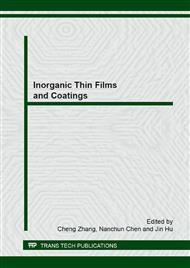p.261
p.265
p.269
p.274
p.279
p.283
p.288
p.292
p.298
Fabrication and Properties of Al-Cr Coatings on the Inner Wall of Steel Pipe by Mechanical Alloying Method
Abstract:
Surface coatings; Mechanical alloying; Microstructure; Tribological properties Abstract. The mechanical alloying method process has been innovatively used to prepare Al-Cr coating on the inner wall of steel pipe. The coating thickness was measured from all samples using optical and Scanning Electron Microscope was used to observe the surface microstructure of Al-Cr coating. Microhardness was analyzed by Digital Microhardness Tester. A wear test was performed by high speed reciprocating friction testing machine. The results show that the coating thickness is 20μm and 26μm at the rotating speed of 200 rpm and 300 rpm, respectively. The surface morphology is significantly influenced by the the rotating speed. When the rotating speed was 200 rpm, a heterogeneous coating surface consisting of flattened particles produced by cold welding with less interparticle contact is formed. When the rotating speed was 300 rpm, the coating became denser and a smooth, highly consolidated and dense coating is formed. The hardness of the Al–Cr coating prepared at 200 and 300 rpm are about 250 Hv and 270 Hv. The friction coefficient of the Al–Cr coating prepared at 200 rpm are about 0.37, 0.39 and 0.24 at the frequencies of 3, 4 and 5 Hz. The friction coefficient of the Al-Cr coating prepared at 300 rpm are about 0.3, 0.18 and 0.28 at the frequencies of 3, 4 and 5 Hz.
Info:
Periodical:
Pages:
279-282
Citation:
Online since:
January 2013
Authors:
Price:
Сopyright:
© 2013 Trans Tech Publications Ltd. All Rights Reserved
Share:
Citation:


